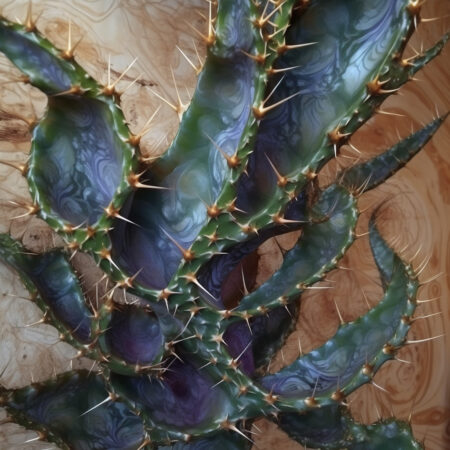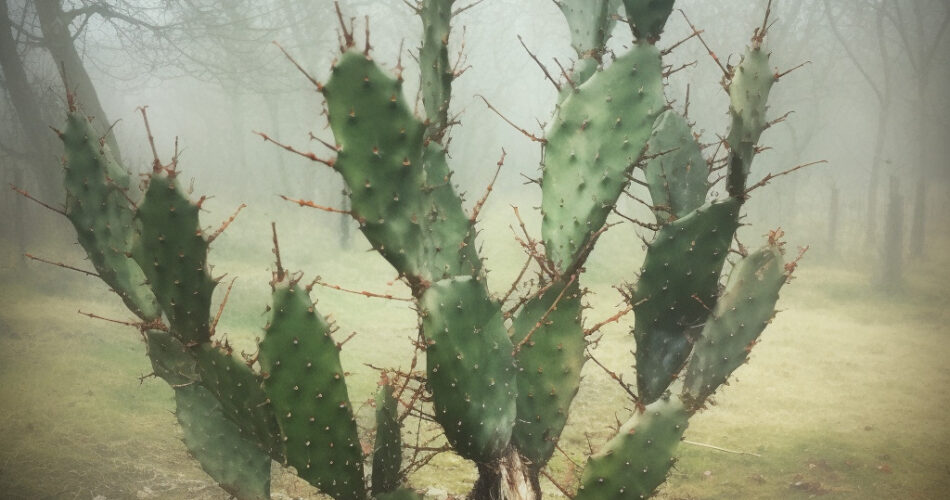Key Takeaways:
- Brasiliopuntia is a fascinating genus of cacti native to South America.
- It has unique adaptations to survive in arid regions and can withstand extreme temperatures.
- It stands out for its distinctive physical features, such as segmented stems covered in spines.
- There are various species of it with different growth requirements and physical attributes.
- Its flowers are known for their delicate beauty, showcasing a variety of colors and shapes.
- The flowers attract pollinators and eventually transform into edible fruits known as prickly pears.
- To care for this cactus, provide it with ample sunlight, well-draining soil, and adjust watering based on the season.
- Pruning and propagating can be done as needed, while pest and disease control measures are important for plant health.
- Natural pest control methods like neem oil and introducing beneficial insects can be used for managing pests.
Unveiling the Mysteries of Brasiliopuntia
Brasiliopuntia, commonly known as the Brazilian pricklypear or lace cactus, is a fascinating genus of cacti that originated in South America. With its unique characteristics and diverse species, this cacti has captivated plant enthusiasts and collectors around the world.
The Fascinating Origins of Brasiliopuntia
It is native to the arid regions of South America, particularly Argentina, Bolivia, Brazil, and Paraguay. It thrives in rocky areas and can withstand extreme temperatures and dry conditions. The genus belongs to the Cactaceae family, which includes several other well-known cactus species.
The discovery of Brasiliopuntia dates back to the 19th century when it was first described by botanists exploring the South American flora. Its unique adaptations to the harsh environment, such as its ability to store water and survive with minimal rainfall, have made it a remarkable specimen in the plant kingdom.
The Unique Characteristics
Brasiliopuntia stands out due to its distinctive physical features. The cactus typically has a shrub-like growth habit, with thick, succulent stems covered in spines. Its stems are segmented, forming distinct pads that give the plant its characteristic appearance.
One of the most intriguing aspects of Brasiliopuntia is its ability to adapt to different environmental conditions. Some species of Brasiliopuntia have developed specialized spines called glochids, which detach easily and can cause skin irritation. These glochids serve as a defense mechanism against herbivores and help the cactus spread its seeds through animal dispersal.
Exploring the Diverse Species
Brasiliopuntia encompasses a wide range of species, each with its own unique characteristics. One of the most well-known species is Brasiliopuntia brasiliensis, which has vibrant green stems and yellow flowers. Another notable species is Brasiliopuntia candelabroides, which forms impressive columnar structures and produces striking pink flowers.
Each species of Brasiliopuntia has its own growth requirements and physical attributes. Some are more cold-hardy, while others prefer warmer climates. By exploring the different species, plant enthusiasts can appreciate the nuances and diversity within the Brasiliopuntia genus.
The Remarkable Beauty of Brasiliopuntia Flowers
While the distinctive stems of this cactus are eye-catching, its flowers are equally breathtaking. The blooms of it are a true testament to the marvels of nature, showcasing an array of colors and shapes.
The Exquisite Blooms
This cactus flowers are known for their delicate beauty. They typically bloom in spring and summer, gracing the cactus with a stunning display of colors. The flowers range from creamy whites and vibrant yellows to shades of pink, orange, and red.
What sets Brasiliopuntia flowers apart is their intricate structure. Each blossom consists of multiple petals that can be flat, ruffled, or even wavy. The flowers are often cup-shaped or saucer-shaped, creating a visually pleasing contrast against the cactus’s spiny stems.
The Spectacular Colors and Shapes
Brasiliopuntia flowers come in a variety of colors, making each species and cultivar unique. Some species, like Brasiliopuntia brasiliensis, boast vivid yellow flowers that bring a burst of sunshine to any garden. Others, such as Brasiliopuntia candelabroides, showcase stunning pink or magenta blooms, creating a striking focal point among the greenery.
Additionally, the shape of Brasiliopuntia flowers adds an element of intrigue. Some species produce rounded or bell-shaped blooms, while others have elongated petals that resemble tubes or trumpets. These unique shapes contribute to the overall allure of Brasiliopuntia flowers and make them highly sought after by collectors.
Understanding the Reproductive Process
The reproductive process of Brasiliopuntia flowers is a fascinating topic that sheds light on the cactus’s ability to adapt and survive in its natural habitat. Like most cacti, Brasiliopuntia relies on pollinators to reproduce.
During the blooming period, the flowers of Brasiliopuntia attract various pollinators, including bees, butterflies, and birds, with their vibrant colors and sweet nectar. These pollinators play a crucial role in transferring pollen from the stamens to the stigma, facilitating fertilization and seed production.
Once fertilized, Brasiliopuntia flowers transform into fruits known as prickly pears or tunas. These fruits are edible and have a unique flavor profile, often described as a blend of watermelon and citrus. They also serve as an important food source for wildlife in their native habitats.

Caring for Brasiliopuntia: Tips and Tricks
Successfully growing Brasiliopuntia requires providing the ideal growing conditions and implementing proper care techniques. By following these tips and tricks, you can ensure the health and vigor of your Brasiliopuntia plants.
Providing the Ideal Growing Conditions
Brasiliopuntia thrives in bright sunlight and requires at least six hours of direct sunlight per day. It is important to place the cactus in a location where it can receive ample sunlight to promote healthy growth.
In terms of soil, Brasiliopuntia prefers well-draining soil with a sandy or gravelly texture. This allows excess water to drain away quickly, preventing root rot. Adding organic matter, such as compost or peat moss, can improve the soil’s fertility and water retention capacity.
When it comes to temperature, most Brasiliopuntia species can tolerate a wide range of climates. However, it is important to protect them from frost during the winter months. Providing a layer of mulch or moving potted specimens indoors can help safeguard against freezing temperatures.
Watering and Fertilizing Strategies
Brasiliopuntia is well-adapted to arid environments and can survive with minimal water. It is essential to practice careful watering to prevent overwatering, which can lead to root rot. Allow the soil to dry out completely between waterings and adjust the frequency based on the season and environmental conditions.
During the growing season, fertilizing can provide additional nutrients to support the cactus’s growth. It is recommended to use a balanced fertilizer specifically formulated for cacti and succulents. Apply the fertilizer sparingly and follow the instructions on the product’s packaging to avoid over-fertilization.
Pruning and Propagating Techniques for This Cacti
Brasiliopuntia generally requires minimal pruning due to its natural growth habit. However, if the cactus becomes too large or develops unhealthy or damaged sections, pruning can be necessary. Use clean, sharp pruning shears to remove unwanted stems or pads. It is important to wear protective gloves to avoid the spines.
Propagating Brasiliopuntia can be achieved through various methods, including stem cutting and seed propagation. Stem cuttings should be taken during the warmer months and allowed to callus before planting in well-draining soil. Seeds can be collected from ripe fruits, cleaned, and sown in a suitable growing medium.
Effective Ways to Deal with Brasiliopuntia Pests and Diseases
While Brasiliopuntia is generally resilient and resistant to pests and diseases, certain issues can arise that require attention. By identifying common pests and diseases and implementing effective control measures, you can ensure the health and vitality of your Brasiliopuntia plants.
Identifying Common Pests Affecting
One of the most common pests that can affect Brasiliopuntia is the cochineal insect. These small, scale-like insects attach to the cactus pads and feed on its sap. The presence of these pests is often indicated by the appearance of white, cotton-like masses on the stems. Manual removal or the use of natural predators can help control cochineal infestations.
Other pests that can occasionally affect Brasiliopuntia include spider mites, mealybugs, and aphids. Regular inspection of the plants and early detection of pests can prevent an infestation from spreading and causing damage.
Preventing and Treating Diseases
Brasiliopuntia is generally resistant to diseases, but certain conditions can lead to fungal or bacterial infections. Overwatering, poor air circulation, and high humidity levels can create an environment conducive to disease development.
To prevent diseases, it is crucial to provide adequate airflow around the plant and avoid overhead watering. Maintaining proper sanitation practices by removing dead or decaying plant material can also help prevent disease-causing organisms from spreading.
If a disease does occur, prompt action is necessary. Treatment may involve removing affected parts of the cactus, applying fungicides or bactericides, and adjusting the growing conditions to discourage further infection.
Natural and Organic Pest Control Methods
For those who prefer natural and organic pest control methods, several options are available for managing pests on Brasiliopuntia. One effective approach is the application of neem oil, a natural insecticide derived from the neem tree. Neem oil acts as a repellent and disrupts the feeding and reproductive cycles of pests.
Another natural pest control method is the introduction of beneficial insects, such as ladybugs or lacewings, which feed on common pests like aphids or spider mites. These predators can help keep pest populations in check and maintain the overall health of the Brasiliopuntia plants.
Brasiliopuntia has an enigmatic beauty that continues to captivate plant enthusiasts worldwide. By understanding its origins, unique characteristics, and diverse species, as well as exploring the remarkable beauty of its flowers, enthusiasts can fully appreciate the allure of this genus. With proper care, including providing ideal growing conditions, implementing effective watering and fertilizing strategies, and employing pest and disease control measures, Brasiliopuntia can thrive and delight both seasoned collectors and beginner gardeners alike.
FAQ
Question: What are the adaptations of Brasiliopuntia to survive in arid regions?
It has the ability to store water and survive with minimal rainfall, making it well-suited for arid environments.
Question: What are glochids and what is their purpose in Brasiliopuntia?
Glochids are specialized spines that detach easily and can cause skin irritation. They serve as a defense mechanism against herbivores and help the cactus spread its seeds through animal dispersal.
Question: How many species of Brasiliopuntia are there and what are their unique characteristics?
There are various species of it, each with its own growth requirements and physical attributes. For example, Brasiliopuntia brasiliensis has vibrant green stems and yellow flowers, while Brasiliopuntia candelabroides forms impressive columnar structures and produces striking pink flowers.
Question: What are some of the colors and shapes of Brasiliopuntia flowers?
This cacti flowers come in a variety of colors, including creamy whites, vibrant yellows, and shades of pink, orange, and red. They can have flat, ruffled, or wavy petals, and are often cup-shaped or saucer-shaped.
Question: How do Brasiliopuntia flowers reproduce?
Its flowers rely on pollinators, such as bees, butterflies, and birds, to transfer pollen from the stamens to the stigma, facilitating fertilization and seed production.
Question: What are prickly pears and how do they relate to Brasiliopuntia flowers?
Prickly pears are edible fruits that develop from fertilized its flowers. They have a unique flavor profile, often described as a blend of watermelon and citrus, and serve as an important food source for wildlife.
Question: What are the ideal growing conditions for Brasiliopuntia?
Brasiliopuntia thrives in bright sunlight, well-draining soil with a sandy or gravelly texture, and temperatures that protect it from frost during winter.
Question: What are some natural pest control methods for managing pests on Brasiliopuntia?
Natural pest control methods for it include the application of neem oil, a natural insecticide, and the introduction of beneficial insects like ladybugs or lacewings to feed on common pests.




Comments